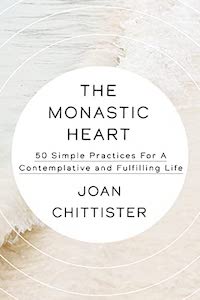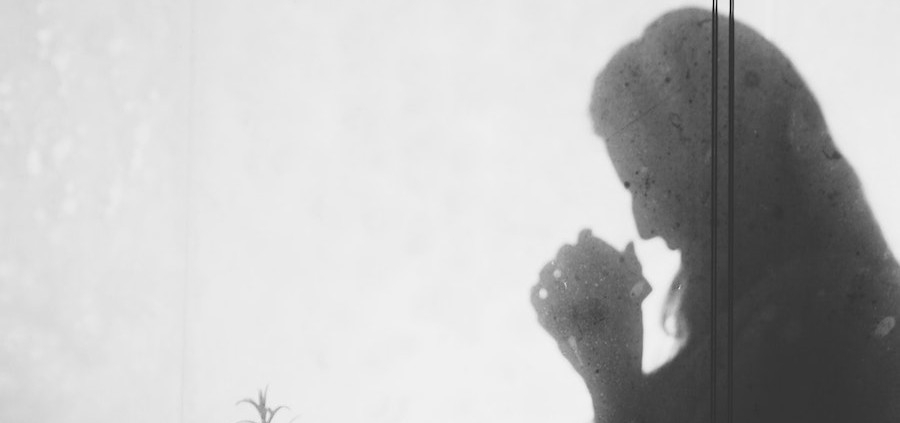The Practice of Presence by Julie A. Ferraro

The Monastic Heart:
50 Simple Practices for a Contemplative and Fulfilling Life
By Joan Chittister, OSB
Convergent New York, 2021
$26.00 288 pp.
In her dedication for The Monastic Heart: 50 Simple Practices for a Contemplative and Fulfilling Life, Sister Joan Chittister cites fellow Erie Benedictine Sister Mary Lou Kownacki—known as “Old Monk” in her own writings—as the inspiration for the book, finding in Sister Mary Lou’s “deep friendship and holy vision . . . a star, a path, and a prod to the words in my heart.”
That could, in some ways, sum up the entirety of this text.
The Covid-19 pandemic also played a major role for Chittister, according to her introduction. “Shaken off our social foundations by a global calamity, an invisible virus we could not see coming, we each found ourselves at the end of certainty and the beginning of faith,” she writes. “The truth is that this deeper part of everyone does not simply develop in us like wild grass. It needs to be cultivated.”
Seeing a challenge in what is being asked of the human spirit under disturbing conditions, Chittister draws from the wisdom of St. Benedict—and those who’ve lived it over the past 1,500 years. She offers 50 brief chapters on various facets of monastic practice. Latin terms such as statio, horarium, lectio, and fuga mundi blend with hospitality, solitude, candles, incense, humility, and more.
It’s not a quick read, though, and nor is it meant to be. “Monasticism is the single-hearted search for what matters in life. Any life. Every life,” Chittister explains. The chapters go on to provide personal insights, historical perspectives, and ways to integrate monastic practices in a direct yet profound manner.
“It’s what you pay attention to in life that determines both your commitments and your inner happiness,” Chittister writes in the first chapter, titled “Bells: On Remembering.”
She promotes ways to reach out to others, to prevent politics, viruses, or “hurts of the heart” from destroying humanity and community. She prompts readers to take a hard look at what they think about, what gets their attention, in order to reorient their souls to what matters most, “the real purpose of life.”
Another point on the road to that purpose is understanding statio, Latin for “station” or “watch.” For Chittister, this implies “giving my whole self to the present moment.” Without mindfulness, consciousness, life is just a series of events where we are present.
The chapter on community pushes that boundary between self and surroundings even further, as the reader is encouraged to integrate the idea that “only in community can you come to truly know yourself, as well as grow to the fullness of yourself.”
Chittister wants the reader to emerge from whatever course they set for reading this book, be it a chapter a week any other schedule, with a mature spiritual life—a life where values are chosen that ground the heart, stretch the vision, and provide new energy without needing to visit or live in a monastery. She frankly states in one of three chapters on humility: “Acceptance of the presence of God in life is the beginning of a real spiritual life rather than simply the exercise of pious practices.”
As shown by St. Benedict’s directives to abbots and prioresses, the superiors of their respective monasteries, leaders must be people-centered, not concerned with profits. Authoritarianism and blind obedience are shunned in favor of listening to discover the gifts of others and cultivate them in a supportive, compassionate manner.
Overall, The Monastic Heart upends the current trends toward consumerism, discrimination, greed, gossip, and exploitation. “We resist the spirit of a world that declares the life of the globe a resource rather than a responsibility,” Chittister writes. She calls for readers to rise up and speak for those without a voice instead of isolating in some safe haven where the needs of others can be ignored.
While Chittister offers her forthright view on over four dozen aspects of monastic life, some chapters don’t really seem to fit. The chapter titled “Incense” gives marvelous insight into the origins of an ancient symbol of the sacred, and invites the reader to experience “another part of life, the part that the pace of modern society tramples.” But no consideration is given for the many for whom incense is a physical irritant, aggravating allergies or asthma. The impression, for those who cannot partake of this particular ritual, is that they are lacking in their spiritual journey because of their physical limitations.
Some of Chittister’s generalizations can be jarring, as in the chapter titled “Manual Labor.” “We work for personal profit, not for the good of the human race,” she writes. This is deeply unfair to those who labor to merely keep a roof over their family’s heads, food on the table and utilities paid, and might be lucky to have enough at the end of a month to buy an ice cream treat for their children. These pages might have been written as a condemnation of the wealthy, but they don’t apply to the majority of those who would be drawn to the book on their quest for spiritual growth.
Chittister earned a doctorate in speech communications theory, has been writing for decades, and is a popular speaker on spiritual topics around the world. She has held leadership positions in her community, as prioress, and with the Leadership Conference of Women Religious and the Conference of American Benedictine Prioresses. Her efforts toward peace, justice, and women’s issues in the church and society have earned her numerous awards. Some of her views have been challenged by church authorities as well, and she continues to speak out about attempts to silence her.
Her summary in the final chapter of this book reflects her wish that the traits of monastic life continue to impact the world, echoing the voice she has used for a half century: “It is the spirit of monasticism that the world recognizes as humanly sound and spiritually healthy—a refuge from institutionalism and a call to personal spiritual depth—when the world is most confused and least healthy.”
For the most part her text inspires that process. Readers should remember, though, that not every point may be applicable to their personal situation, and should not feel any less worthy to follow the path if they can’t integrate all the practices as recommended. ♦
Julie A. Ferraro has been a journalist for over 30 years, covering diverse beats for secular newspapers as well as writing for many Catholic publications. A mother and grandmother, she currently lives in Atchison, Kansas. Her column, “God ‘n Life,” appears regularly in Today’s American Catholic.





Leave a Reply
Want to join the discussion?Feel free to contribute!